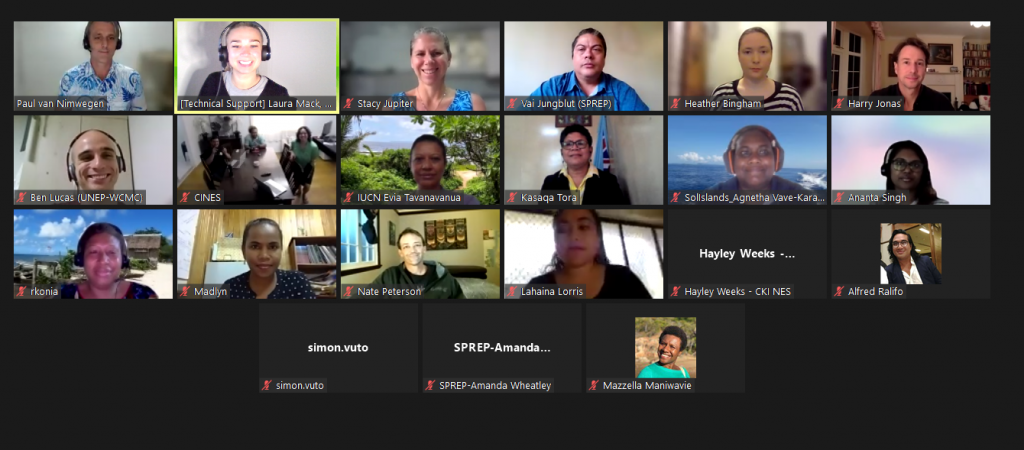
The Pacific region has made encouraging progress over the past eleven years with approximately 20 percent of the total marine area within Exclusive Economic Zones of the region coming under formal protection.
Community-based conservation rooted in traditional governance systems is widely practiced in the Pacific region. These models have achieved success in supporting community livelihoods and sustaining conservation outcomes. However, current data indicates that most of these areas are not included in national area coverage reporting.
This highlights a greater need to increase the recognition of, and support for, these areas. One way to do this is through the identification and recognition of other effective area-based conservation measures or OECMs.
In 2018, Parties to the Convention on Biological Diversity (CBD) formulated an agreed definition for OECMs, which are areas where positive and sustained conservation outcomes are being achieved. However, this may not necessarily be their primary management objective.
The BIOPAMA Pacific virtual training workshop on OECMs was held 10-12 August 2021 and was co-organised by the Secretariat of the Pacific Regional Environment Programme (SPREP), IUCN Oceania and the UN Environment Programme World Conservation Monitoring Centre (UNEP-WCMC).
The virtual training 29 participants learn more about OECMs and how to identify, recognise, support and report on these areas, from both a regional and individual country perspective.

“Other effective area-based conservation measures are a relatively new concept to the Pacific islands region. Notwithstanding this, I am confident that many existing areas within our region qualify as OECMs and stand to benefit from this designation” Said Mr Vainuupo Jungblut, Protected Areas Officer at SPREP.
“This training is timely as it has provided valuable insights, understanding and clarity over what OECMs are, implications for the region and individual countries, their potential benefits and challenges as well as important discussions around supporting the inclusion of these areas in national reporting.”
Led by UNEP-WCMC the training facilitated better understanding of OECMs and their potential application in the region. Participant feedback was also captured on the identification and recognition process for these areas, including who should be involved in each step, and issues and considerations arising.
The virtual sessions introduced the OECM concept in both the global and Pacific setting, including an overview of perceived opportunities and challenges and an introduction to the World Database on OECMs managed by UNEP WCMC.
Practical activities helped familiarise participants with the OECM screening tool-site-based methodology and guidance for recognising and reporting OECMs developed by an IUCN World Commission on Protected Areas taskforce.
“I found the training very useful and informative. It has provided me with a good basic understanding of what OECMs are and how they could potentially be captured in the context of my own country,” said Ms. Agnetha Vave-Karamui of the Solomon Islands Environment Ministry, MECDM.
“An important consideration for Solomon Islands is that the process for OECMs is as consultative and inclusive as possible and actively engages communities, landowners and resource owners, men, women, youths, traditional leaders, rights holders and those having customary interests. Also, provincial government, members of provincial assemblies and relevant ministries of the national government.”
OECMs can contribute to a country’s reporting on global targets associated with the Convention on Biological Diversity and are firmly entrenched in Action Target 3 of the new Global Biodiversity Framework up to 2030. In light of this, an anticipated process and official requirements for reporting OECMs at the global level were outlined and discussed.
An outcome of the training will be to further support countries with the identification of OECMs at the national level by applying the screening tool and guidance to multiple potential sites. Participant feedback received over the three days of the training will also define further next steps - around the recognition, support and reporting aspects of OECMs.
Participants attended the BIOPAMA Pacific virtual training workshop from the Cook Islands, Federated States of Micronesia, Palau, Samoa, Solomon Islands, Tonga and Vanuatu. Regional partner organisations that participated included The Nature Conservancy, Wildlife Conservation Society and WWF-Pacific.
The virtual training was funded by BIOPAMA, an initiative of the Organisation of African, Caribbean and Pacific (OACPS) Group of States financed by the European Union 11th European Development Fund. In the Pacific, the project is implemented by IUCN Oceania in partnership with SPREP and the European Commission Joint Research Centre. This partnership has assisted the SPREP Regional Programme of Support for Protected Areas to become a decision-making support hub, including delivering capacity building activities and training in the use of BIOPAMA support tools and services. It has also seen significant enhancements of the Pacific Islands Protected Area Portal, the region’s one-stop resource for protected area information.
To learn more about the BIOPAMA regional resource and data hub, please contact Mr. Vainuupo Jungblut, Protected Areas Officer on email: [email protected].
To learn more about the BIOPAMA Programme, please contact Mr. Paul van Nimwegen, Protected and Conserved Areas Programme Coordinator / BIOPAMA Regional Coordinator, IUCN ORO on email: [email protected].
For more information on the WD-OECM, you can visit the website by clicking here, or by emailing [email protected].